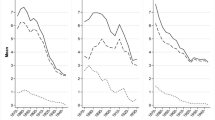Abstract
Using discrete-time survival models of parity progression and illustrative data from the Philippines, this article develops a multivariate multidimensional life table of nuptiality and fertility, the dimensions of which are age, parity, and duration in parity. The measures calculated from this life table include total fertility rate (TRF), total marital fertility rate (TMFR), parity progression ratios (PPR), age-specific fertility rates, mean and median ages at first marriage, mean and median closed birth intervals, and mean and median ages at childbearing by child’s birth order and for all birth orders combined. These measures are referred to collectively as “TFR and its components.” Because the multidimensional life table is multivariate, all measures derived from it are also multivariate in the sense that they can be tabulated by categories or selected values of one socioeconomic variable while controlling for other socioeconomic variables. The methodology is applied to birth history data, in the form of actual birth histories from a fertility survey or reconstructed birth histories derived from a census or household survey. The methodology yields period estimates as well as cohort estimates of the aforementioned measures.




Similar content being viewed by others
Notes
Alternatively, a single 0–1 transition can be used in place of the B–M and M–1 transitions.
Medians show patterns similar to those shown for means.
References
Feeney, G., & Yu, J. (1987). Period parity progression measures of fertility in China. Population Studies, 41, 77–102.
Luther, N. Y., & Cho, L. J. (1988). Reconstruction of birth histories from census and household survey data. Population Studies, 42, 451–472.
Retherford, R. D., Eini-Zinab, H., Choe, M. K., Ogawa, N., & Matsukura, R. (2011). Further development of methodology for multivariate analysis of the total fertility rate and its components based on birth-history data (East-West Center Working Paper 122). Honolulu, HI: East-West Center. Retrieved from http://www.eastwestcenter.org/fileadmin/stored/pdfs/popwp122.pdf
Retherford, R. D., Ogawa, N., Matsukura, R., & Eini-Zinab, H. (2010). Multivariate analysis of parity progression-based measures of the total fertility rate and its components. Demography, 47, 97–124.
Acknowledgments
Support for this research was provided by Grant R01HD057038 from the U.S. National Institutes of Health and by a grant obtained by the Nihon University Population Research Institute from the Academic Frontier Project for Private Universities: matching fund subsidy from MEXT (Japan Ministry of Education, Culture, Sports, Science and Technology), 2006–2010.
Author information
Authors and Affiliations
Corresponding author
Electronic supplementary material
Below is the link to the electronic supplementary material.
ESM 1
(PDF 164 kb)
Rights and permissions
About this article
Cite this article
Retherford, R.D., Eini-Zinab, H., Choe, M.K. et al. Multidimensional Life Table Estimation of the Total Fertility Rate and Its Components. Demography 50, 1387–1395 (2013). https://doi.org/10.1007/s13524-012-0179-8
Published:
Issue Date:
DOI: https://doi.org/10.1007/s13524-012-0179-8




